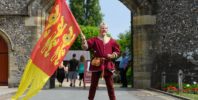
Chiddingstone is one of the prettiest and oldest villages in Kent, perhaps England, and has been described as “the most perfect surviving example of a Tudor village in the country“.
Bought by the NT in 1939 to ensure preservation of the entire village, it is built in a very typical Kent style, with half-timbered sides, gables and stone-hung red tiled roofs. The properties are very attractive examples of 15th and 16th century domestic architecture.
The Village Shop and Post Office date back as early as 1453 and is believed to be the oldest working shop in the country. It is said that Sir Thomas Boleyn, father of Anne Boleyn, owned the shop for approximately 9 years. In 1593, it was taken over by a Tailor and boasted 2 counters. Now a village shop open daily, it sells a wide range of gifts including jewellery, greeting cards, traditional sweets, ice cream and local produce.
The Tea room, now known as The Tulip Tree, is based in a converted coach house behind the village shop and is open daily 10-5 for breakfast and lunch as well as cakes, scones with clotted cream and Kent strawberry jam, as well as traditional afternoon tea. This is a very popular venue for walkers, cyclists and visitors to the village due to the location and reputation.
A theory is that Chiddingstone takes its name from the 135million old sandstone outcrop known as the ‘Chiding Stone’. Tradition asserts that the stone was used as a seat of judgement, mainly to remonstrate overbearing local wives and wrong-doers.
The village has been used in numerous films including “A Room with a View” with Helen Bonham Carter, Michael Winners production of ‘The Wicked Lady’, Terry Jones and the “Monty Python” team for ‘Wind in the Willows’ and ‘Elizabeth R’, starring Glenda Jackson.
The parish church, is another fine building and is perhaps the fourth built on that site. The earliest record of a church in Chiddingstone dates back to 1120, and the oldest parts of the existing church were built in the 13th century but it was substantially rebuilt in the 14th century. The fine west tower with its stair turret and four pinnacles was added in the 15th century. A lightning strike in 1624 destroyed all but the tower, the church was then rebuilt in 1629. The font was made in 1628 of local sandstone and has been described as the best production of its period in Kent.
Chiddingstone Castle can be traced back to the early 1500s, and during its life, the castle has undergone a number of architectural changes and has been owned and lived in by an eclectic mix of people and families. The castle served as a base for military forces during the Second World War, and then as a school until 1955 when the castle was purchased by Denys Eyre Bower (1905-1977), a former bank clerk and antiques dealer, in order to display his collections. Since 1977, it has been held in trust by the Denys Eyre Bower Bequest and both garden and castle are open to the public.
Local places to visit include Penshurst Place, Hever Castle and Bough Beach reservoir plus National Trust properties Ightham Mote, Chartwell, Emmets and Knole House.
For more information and to plan your trip to The Tulip Tree please visit:-
Tel: 01892 871504
Web: www.thetuliptree.biz






